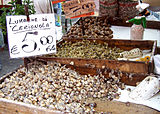- Arctica islandica
-
Ocean quahog 
A shell of Arctica islandica with the valves separated Scientific classification Kingdom: Animalia Phylum: Mollusca Class: Bivalvia Order: Veneroida Family: Arcticidae Genus: Arctica Species: A. islandica Binomial name Arctica islandica
Linnaeus, 1767Arctica islandica, commonly known as the ocean quahog, is an edible marine bivalve mollusk native to the North Atlantic ocean, which is harvested commercially. This species is also known by a number of different common names, including Icelandic cyprine,[1] mahogany clam, mahogany quahog, black quahog, and black clam.[2]
The typical Arctica islandica resembles the quahog, but the shell of the ocean quahog is rounder, the periostracum is usually black, and on the interior of the shell, the pallial line has no indentation, or sinus. Unlike the quahog, which lives intertidally and can be collected by clam digging, this species lives subtidally, and can only be collected by dredging. They grow to sizes exceeding 50 mm shell height.[3]
These animals show exceptional longevity and have been estimated to live up to 400 years in the wild.[4] In 1868 one specimen, collected alive near Iceland, was 374 years old. The study of its growth rate and the oxygen isotope data showed that it had a highly variable growth at the peak of the Little Ice Age around 1550-1620 and mild climate near its end around 1765-1780 and had recorded the volcanic eruption of Mount Tambora in 1815. [5] One study found that in animals aged 4–192 years, antioxidant enzymes declined rapidly in the first 25 years, which includes the growth and sexual maturity stages, but afterwards remained stable for over 150 years. Though more detailed studies are warranted, it appears this species is a case of negligible senescence.[6]
See also
Notes
- ^ Sabatini, M. & Pizzola, P.F., 2007. Arctica islandica. Icelandic cyprine. Marine Life Information Network: Biology and Sensitivity Key Information Sub-programme [on-line]. Plymouth: Marine Biological Association of the United Kingdom. [cited 14 September 2007]. Available from: <http://www.marlin.ac.uk/species/Arcticaislandica.htm>
- ^ Hackney, Cameron R.; Thomas E. Rippen (2000). "The Molluscan Shellfish Industry". In Roy E. Martin, Emily Paine Carter, Jr., George J. Flick, Lynn M. Davis. Marine and Freshwater Products Handbook. CRC Press. pp. 323–324. ISBN 1566768896.
- ^ R. Witbaard, M.J.N. Bergman (2003). "The distribution and population structure of the bivalve Arctica islandica L. in the North Sea: what possible factors are involved?". Journal of Sea Research 50: 11–25. http://www.vliz.be/imisdocs/publications/56725.pdf.
- ^ http://www.sciencedaily.com/releases/2007/10/071028100032.htm
- ^ Schone B.R. et al. 2005. Palaeogeography, Palaeoclimatology, Palaeoecology 228, 130-148.
- ^ http://genomics.senescence.info/species/entry.php?species=Arctica_islandica
External links
- Ocean quahog, Arctica islandica, Life history and habitat from the NOAA.
- Climate records from a bivalved Methuselah
Commercial mollusks Marine gastropods - Abalone
- Periwinkle
- Whelk
- Buccinum undatum
- Bullacta exarata

Land and freshwater gastropods - Helix pomatia
- Helix aspersa
- Helix aperta
- Cepaea nemoralis
- Otala lactea
- Escargot
Free-swimming marine bivalves - Scallop
- Queen scallop
- Pecten maximus
- Pecten jacobaeus
- Argopecten irradians
- Placopecten magellanicus
Infaunal bivalves - Clam
- Mercenaria mercenaria
- Austrovenus stutchburyi
- Saxidomus nutalli
- Arctica islandica
- Cockle
- Geoduck
- Spisula solidissima
- Paphies ventricosa
- Paphies australis
- Tuatua
- Ruditapes largillierti
- Grooved carpet shell
Sessile bivalves Freshwater bivalves Cephalopods Techniques Edible mollusks Bivalves Atlantic jackknife • Atlantic surf • Geoduck • Grooved carpet shell • Hard clam • Horse • Mactra stultorum • Blunt gaper • Ocean quahog • Pacific razor • Pecten jacobaeus • Venus • California butterclam • Senilia senilis • Smooth clam • Soft-shell • Triangle shell • Tuatua • Japanese littleneck • Razor clam • Pod razor • Ensis (razor genus) • PaphiesBlue • Mediterranean • New Zealand green-lipped • California • Brown • Asian/Philippine green • Date • Mytilidae (mussel family)Auckland • Eastern • Olympia • Southern mud • Colchester native • Pacific • Portuguese • Windowpane • Rock • Sydney rock • Ostra chilena/Bluff • Gillardeau oysters • Crassostrea ("true oyster" genus)Gastropods Queen • DogBlack foot opihi/Haiwaiian • China • Common European • Rayed Mediterranean • Ribbed Mediterranean • Rustic • Turtle/Talc • Yellow foot opihiLandFreshwaterNeritesInkfish Spineless • BottletailChitons Chiton magnificus • Acanthopleura granulataCategories:- Arcticidae
- Edible molluscs
Wikimedia Foundation. 2010.


